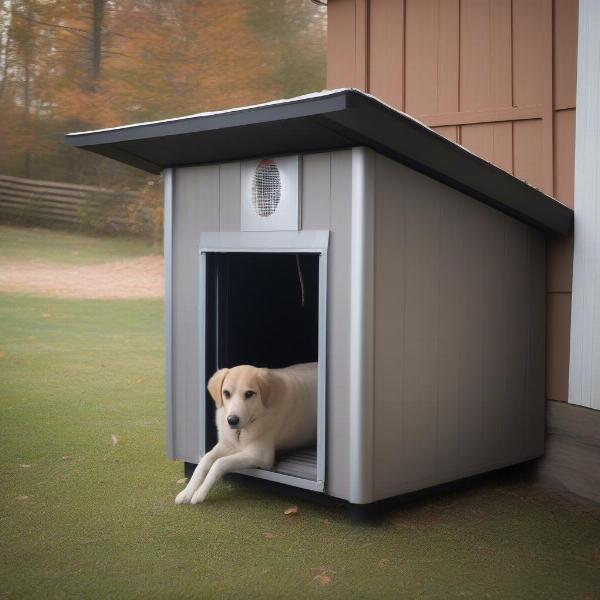Heaters for dogs are essential for ensuring your furry friend’s comfort and well-being, particularly during colder months. Whether your dog spends time outdoors in a dog house, or simply prefers a warm spot to curl up inside, choosing the right heater can make a significant difference. This article will explore the various types of dog heaters available, factors to consider when selecting one, and safety tips for using them.
Types of Dog Heaters
Choosing the right heater for your dog depends on various factors, including your dog’s size, breed, age, and living situation. Here’s a breakdown of the common types:
- Electric Heaters: These are often used for indoor dog beds or houses. They typically have a low wattage and safety features to prevent overheating. Some models come with chew-resistant cords for added safety.
- Ceramic Heaters: These heaters emit radiant heat and are energy-efficient. They are a good option for providing supplemental warmth in a specific area.
- Panel Heaters: These heaters radiate heat evenly and are often used for larger spaces like dog houses. They are generally safe and energy-efficient.
- Heated Pads and Mats: These provide a warm surface for your dog to lie on. They are ideal for indoor use and come in various sizes and temperature settings.
- Microwaveable Heat Pads: These offer a convenient and portable heating solution. Simply heat them in the microwave and place them in your dog’s bed.
Factors to Consider When Choosing a Heater for Dog
Selecting the appropriate heater for your dog involves careful consideration of several crucial factors:
- Safety: This is paramount. Look for heaters with automatic shut-off features, chew-proof cords, and overheat protection.
- Size and Breed: Larger dogs may require more powerful heaters, while smaller breeds might be comfortable with a heated pad. Consider your dog’s coat thickness as well. A short-haired dog will need more warmth than a double-coated breed.
- Indoor or Outdoor Use: Choose a heater designed specifically for the intended environment. Outdoor heaters need to be weatherproof and durable.
- Energy Efficiency: Opt for energy-efficient models to reduce your electricity bill and minimize your environmental impact.
- Ease of Use and Cleaning: Select a heater that is easy to set up, operate, and clean.
Safety Tips for Using Dog Heaters
While heaters provide warmth and comfort, it’s crucial to prioritize safety:
- Never leave a heater unattended. Always supervise your dog when using a heater.
- Regularly inspect the heater for any damage, such as frayed cords or exposed heating elements.
- Place the heater out of your dog’s reach, if possible, to prevent chewing or accidental burns.
- Follow the manufacturer’s instructions carefully.
 Outdoor Dog House Heater
Outdoor Dog House Heater
Keeping Your Dog Warm Without a Heater
If you prefer not to use a heater, there are alternative ways to keep your dog warm:
- Provide warm bedding: Use thick blankets, dog beds, or even old sweaters to create a cozy sleeping area.
- Elevate the dog bed: Raising the bed off the cold floor can help insulate your dog.
- Allow your dog to sleep indoors during particularly cold nights.
- Use a dog coat or sweater for added warmth, especially for short-haired breeds.
Conclusion
A heater for dog can be a valuable investment in your pet’s comfort and well-being, especially during the colder months. By carefully considering the various types of heaters available, prioritizing safety, and following the guidelines outlined in this article, you can ensure your canine companion stays warm, safe, and happy throughout the year. Remember to prioritize safety and always supervise your dog when using a heater.
FAQ
- What type of heater is best for a dog house? Panel heaters or ceramic heaters designed for outdoor use are generally recommended for dog houses.
- Are heated dog beds safe? Yes, provided they are used according to the manufacturer’s instructions and have safety features like automatic shut-off.
- Can I use a human heater for my dog? It’s generally not recommended, as human heaters may not have the necessary safety features for pets.
- How can I tell if my dog is too cold? Signs of a cold dog include shivering, curling up tightly, and seeking warmth.
- What temperature should a dog house be kept at? The ideal temperature range for a dog house is between 50-60°F (10-15°C).
- Can I use a blanket instead of a heater? Blankets can provide some warmth, but a heater may be necessary in extremely cold temperatures.
- What should I do if my dog chews on the heater cord? Immediately unplug the heater and consult a veterinarian if your dog shows any signs of injury or illness.
Related Articles
- small heater for dog house
- heater for dog house outside
- dog heater for dog house
- battery powered dog house heater
ILM Dog is a leading online resource for dog owners worldwide, dedicated to providing expert advice on all aspects of dog care, from breed selection and health to training, nutrition, and grooming. We offer practical, reliable information to help you provide the best possible care for your canine companion. For further assistance or personalized advice, please contact us via email at [email protected] or phone at +44 20-3965-8624. ILM Dog is committed to helping you navigate the joys and challenges of dog ownership.